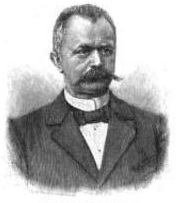Related Research Articles

Paul Leppin was a 20th-century Bohemian writer of German language, who was born and lived in Prague.

Franz Steindachner was an Austrian zoologist, ichthyologist, and herpetologist. He published over 200 papers on fishes and over 50 papers on reptiles and amphibians. Steindachner described hundreds of new species of fish and dozens of new amphibians and reptiles. At least seven species of reptile have been named after him.

Anton Ausserer was an Austrian naturalist specialising in spiders. His father died when he was a youth, and he and his family suffered much economic hardship, but he was supported and encouraged by Camill Heller, professor of Zoology and Comparative Anatomy at the University of Innsbruck.

Anton Kerner Ritter von Marilaun, or Anton Joseph Kerner, was an Austrian botanist and professor at the University of Vienna. The standard author abbreviation A.Kern. is used to indicate this person as the author when citing a botanical name.
Karl Grobben was an Austrian biologist. He graduated from, and later worked at, the University of Vienna, chiefly on molluscs and crustaceans. He was also the editor of a new edition of Carl Friedrich Wilhelm Claus' Lehrbuch der Zoologie, and the coiner of the terms protostome and deuterostome.

Prof Karl (Carl) Theodor Ernst von Siebold FRS(For) HFRSE was a German physiologist and zoologist. He was responsible for the introduction of the taxa Arthropoda and Rhizopoda, and for defining the taxon Protozoa specifically for single-celled organisms.

Friedrich Moritz Brauer was an Austrian entomologist who was Director of the Naturhistorisches Hofmuseum, Vienna, at the time of his death. He wrote many papers on Diptera and Neuroptera.

Karl Wilhelm Gottlieb Leopold Fuckel was a German botanist who worked largely on fungi.

Adolph Eduard Grube was a German zoologist. He served as a professor at the University of Dorpat before moving to Wrocław.

Mesoniscus is a genus of woodlice, placed in its own family, Mesoniscidae, and section, Microcheta. It contains two species – Mesoniscus alpicolus and Mesoniscus graniger – that live in Central and Eastern Europe, mostly in and around caves.

August Bernhard Brauer was a German zoologist.

Veit Graber latinized as Vitus Graber was an Austrian pioneer of insect physiology, embryology, anatomy, and behaviour. He conducted experiments to demonstrate insect senses and perception while also looking at the structures responsible for them. He was the first to identify what he termed as chordotonal organs. A muscular and pear-shaped structure of unknown function found in the larvae of horseflies described by him is now known as Graber's organ. He was the author of several major books on insects including Die Insekten (1877–78).
Walkeria tuberosa is a species of colonial bryozoan in the order Ctenostomatida. It is native to the Mediterranean Sea, and has spread to the Red Sea and the Indo-Pacific region.

Ascidia incrassata is a sea squirt in the family Ascidiidae and was first described in 1878 by Camill Heller.
Ascidia caudata is a sea squirt in the family Ascidiidae and was first described in 1878 by Camill Heller.

Herdmania grandis is a species of sea-squirt in the family Pyuridae.

Asterocarpa humilisis a species of ascidian first described in 1878 as Styela humilis by Camill Heller.
Herdmania pallida is a species of sea-squirt in the family Pyuridae.

Microscosmus exasperatus is a species of tunicate in the family, Pyuridae, and was first described in 1878 by Camill Heller.

Pyura gibbosa is a species of sea-squirt in the family, Pyuridae, and was first described in 1878 as Cynthia gibbosa by Camill Heller.
References
- ↑ "Heller Kamill". Österreichisches Biographisches Lexikon 1815–1950 (ÖBL). Band 2 [Austrian Biographical Dictionary](PDF) (in German). Verlag der Österreichischen Akademie der Wissenschaften, Wien. 1959. p. 260.
- ↑ Hans G. Hansson. "Dr. Camill Heller". Biographical Etymology of Marine Organism Names. Göteborgs Universitet. Archived from the original on 2012-07-17. Retrieved 2010-06-05.